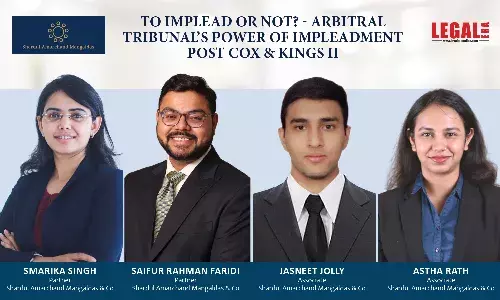Remedy worse than the disease

Remedy worse than the disease NCLAT's stand in the Tata-Mistry controversy was a curious mix of over-reach and under-reach In a landmark judgment passed by the Hon'ble Supreme Court on 26 March 2021, one of the most high-profile board room battles between the Tata Sons Group (Tata Group) and Cyrus Mistry Group (Mistry Group) was decided with the Apex Court ruling in favor of the...
Remedy worse than the disease
NCLAT's stand in the Tata-Mistry controversy was a curious mix of over-reach and under-reach
In a landmark judgment passed by the Hon'ble Supreme Court on 26 March 2021, one of the most high-profile board room battles between the Tata Sons Group (Tata Group) and Cyrus Mistry Group (Mistry Group) was decided with the Apex Court ruling in favor of the Tata Group.1
The said case arose out of a batch of 15 civil appeals, 14 of which were preferred by the Tata Group, assailing the order dated 18 December 2019 passed by the National Company Law Appellate Tribunal (NCLAT). The Mistry Group, too, preferred a cross-appeal, seeking more reliefs than what had been granted by the NCLAT which, inter-alia, included a direction to provide them proportionate representation on the Board of Directors of Tata Sons Limited.
The Supreme Court, while hearing the appeals, gave its findings on a host of issues thereby embellishing several facets of company law jurisprudence. The questions for consideration before the Court, inter-alia, included:
i. Whether the affairs of the Tata Group were being conducted in a manner prejudicial and oppressive to the minority shareholders
ii. Whether the reinstatement of Cyrus Mistry as Executive Chairman of Tata Sons Limited was valid
iii. Whether the NCLAT could mute the powers of the Company and/or the Directors by nullifying the effect of the Articles of Association of a Company, without an expression challenge made to set aside the same.
Among various issues, one key issue which emerges on the face of the judgment and the issues so raised therein is that of the scope of power of the tribunal (NCLT/NCLAT), which has been established under and derives its powers from, specific statute(s). This article focuses on the aforementioned key issue by endeavoring to delve into the confines of adjudicatory powers of tribunals and the need to distinguish the fine line between judicial purview and commercial wisdom.
Advent of Tribunals
The advent of tribunalisation in India can be traced back to the 42nd Amendment to the Constitution of India whereby Part XIVA was added which included Articles 323A and 323B, providing for the constitution of tribunals dealing with administrative matters and other issues, respectively. The rationale of setting up tribunals was essentially to create specialised adjudicating authorities which could effectively discharge judicial functions in a speedy and specialised manner, within the parameters that would not violate the integrity of the judicial system.2
For consolidating the matters pertaining to the companies, the Government constituted a high-level committee on the law relating to insolvency of companies under the Chairmanship of Justice V. Balakrishna Eradi3. This resulted in the creation of NCLT and NCLAT which were vested with all the powers and jurisdiction of the Company Law Board, the Board for Industrial and Financial Reconstruction, the Appellate Authority for Industrial & Financial Reconstruction and the entire jurisdiction of the High Court(s) relating to Company Law matters.
Accordingly, the Companies Act was modified in 2002. Thereafter, with the promulgation of the Insolvency and Bankruptcy Code, 2016 (Code), NCLT and NCLAT were vested with the adjudicatory powers and jurisdiction for all matters under the Code.
Analysing the scope of inherent power of the NCLT/NCLAT
The powers of NCLT and NCLAT have been provided under various provisions of the Companies Act, 2013 as well as the Code. Rule 11 of the NCLT Rules, 2016 and the NCLAT Rules, 2016 specifically provide 'inherent powers' to the tribunals to pass such orders or give such directions as may be necessary for meeting the ends of justice or to prevent abuse of process of the tribunal. These inherent powers pronounce equity as an integral part of these tribunals4.
These inherent powers, though written in letter of law, cannot be deemed to be absolute in nature, wherein, the tribunals could act dehors the mandate of the law. For example, it is a well-settled proposition that the tribunals cannot traverse the four walls of a statute that it itself is a creature of.
The approach of the NCLAT in the instant case appears to be that of acting in a manner that is not optimum to its corresponding powers and duties. While on one hand, the NCLAT went far beyond its mandate to pass an order which was not even pleaded by either of the parties, i.e., reinstatement of Cyrus Mistry as the Executive Chairman; on the other hand, it failed to adjudicate the issues which were specifically raised before it. A rare case of over-reach and under-reach, within the same order.
The over-reach
The declaration of appointment of Natarajan Chandrasekaran as 'Executive Chairman' as illegal, and the reinstatement of Cyrus Mistry for the 'rest of the tenure' was ultra-vires to the pleadings made before the NCLAT. This apparent oversight was corrected by the Apex Court, which observed as under:
157. The judgment of the NCLAT was passed on 18.12.2019, by which time, a period of nearly 7 years had passed from the date of CPM's appointment as Executive Chairman. Therefore, we fail to understand: (i) as to how NCLAT could have granted a relief not apparently sought for (though wished for); and (ii) what NCLAT meant by reinstatement "for the rest of the tenure". That the question of reinstatement will not arise after the tenure of office had run its course, is a settled position.
The position of the 'Executive Chairman', as observed by the Apex Court is not a legal or statutory position recognized under the law. It is a designation resulting out of the creation of the company and its board of directors. For NCLAT to decide on such a matter would imply that the NCLAT took sufficient liberty, to trespass and enter into the board room and take board-like decisions. Not only did the NCLAT go to the extent of reinstating CPM on the Board of Tata Sons, but also on the Board of Tata Group companies. The said companies were not even parties to the proceedings, without there being any complaint against those companies under Section 241 of the Companies Act and without there being any prayer against them.
The NCLAT clearly acted in excess of its jurisdiction by rendering the aforementioned finding. Had it not been for the Supreme Court, then findings like these might have resulted in ramifications that could seriously compromise the independence of the board. This, in turn, could severely dampen and jeopardize the spirit and vision of corporate governance in the country.
The under-reach:
Paradoxically, the NCLAT, as observed by the Supreme Court, was lackadaisical in its approach to adjudicate upon all such issues that had been categorically raised before it. The Apex Court observed that none of the findings of the NCLT, except the one relating to the removal of Cyrus Mistry was specifically and individually overturned by NCLAT.
The NCLT dealt with each and every allegation in an elaborate manner, which can be broadly categorized under the following heads:
• Transactions with Siva and Sterling Group of Companies
• Diversion of funds by Air Asia Pvt. Ltd. through global terrorists
• Transactions with Mehli Mistry
• Nano Car project and losses suffered by Tata Motors
• Acquisition of Corus
• The oppressive nature of Articles 104B, 121, 121A and 75
• Removal of Cyrus Mistry
• Interference by Nominee Directors
• The affirmative voting rights of the Directors
• The Conversion of Tata Sons into a private company
• Wellspun Acquisition by Tata Power
The findings recorded by NCLAT, on the contrary, revolved primarily around the removal of Cyrus Mistry, the affirmative voting rights, interference by nominee Directors and the conversion of Tata Sons into a private company only. This hasty approach of the NCLAT even left the Hon'ble Apex Court curious to the extent of them recording as under:
45. While NCLT dealt with every one of the allegations contained in the main company petition and recorded its findings, NCLAT, curiously, focused attention only on (i) the removal of CPM (ii) the affirmative voting rights of the Directors nominated by the 2 Trusts in the decision making process and (iii) the amended certificate of incorporation issued by the RoC, deleting the word "Public" and making it a private company once again.
47. As pointed out at the beginning of chapter 7, NCLT dealt with every one of the allegations of oppression and mismanagement and recorded reasoned findings. But NCLAT, despite being a final court of facts, did not deal with the allegations one by one nor did the NCLAT render any opinion on the correctness or otherwise of the findings recorded by NCLT. Instead, the NCLAT summarised in one paragraph, namely paragraph 183, its conclusion on some of the allegations, without any kind of reasoning.
It is a well-settled principle that the findings of the NCLT, not specifically modified or set aside by NCLAT should be taken to have reached finality unless the parties aggrieved by such non-interference by NCLAT would approach the Supreme Court. The fact that the Mistry Group further approached the Supreme Court against certain findings/non-findings of the NCLAT can be construed as a failure on part of the NCLAT for not having taken due cognizance of such reliefs prayed by the parties.
This is effectively an act of under-reach wherein the NCLAT, being the final court of fact, failed to adjudicate upon the issues specifically prayed therein by either of the parties. The tribunal failing to exercise the jurisdiction so vested upon it under the law is as much an error in law as it is in exceeding the jurisdiction vested in it under the same law.
Conclusion
The Supreme Court summarised the position of the NCLAT in the instant case to be that of eliminating the discipline in pleadings and procedure, instead of eliminating delays.
As suggested by the Apex Court, the purpose of an order, as passed by the company law tribunal, is to bring to an end the matters complained of, by providing a solution. Such a complain may either be that of "oppressive conduct" or "unfairly prejudicial conduct" or mere "prejudicial conduct".
The Supreme Court rightfully observed that the object cannot be to provide a remedy worse than the disease. In other words, the aim of the courts must be to put an end to the matters complained of and not to put an end to the company itself, forsaking the interests of other stakeholders. The courts must always keep in mind the purpose for which remedies are made available under various provisions, before granting relief or issuing directions. It is on the touchstone of the objective behind these provisions that the correctness of the reliefs granted by the tribunal should be tested.
2 Statement of Object and Reasons, The Constitution (42nd Amendment) Act, 1976
3 The Justice Eradi Committee On Law Relating To Insolvency Of Companies was constituted on 22-10-1999 which recommended the formation of the NCLT and NCLAT.
4 Union of India v. R. Gandhi, (2010) 3 CTC 517
Disclaimer – The views expressed in this article are the personal views of the authors and are purely informative in nature.




